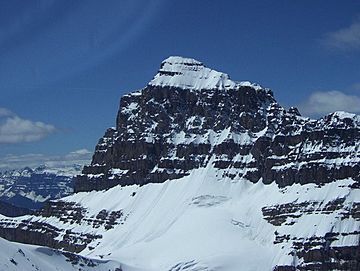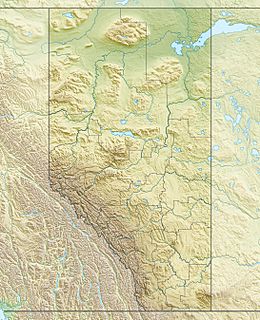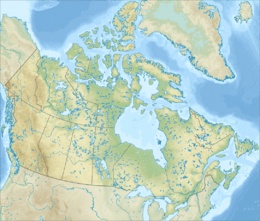Mount Cline facts for kids
Quick facts for kids Mount Cline |
|
|---|---|

Mount Cline in June 2008
|
|
| Highest point | |
| Elevation | 3,361 m (11,027 ft) |
| Prominence | 1,196 m (3,924 ft) |
| Listing | Mountains of Alberta |
| Geography | |
| Location | Alberta, Canada |
| Parent range | Cline Range Canadian Rockies |
| Topo map | NTS 83C/02 |
| Climbing | |
| First ascent | 1927 by J. H. Barnes, A. L. Castle, A. L. Castle Jr., Jimmy Simpson, guided by Rudolph Aemmer |
Mount Cline is a tall mountain located in western Alberta, Canada. It stands about 11 kilometers (7 miles) north of Saskatchewan Crossing. It is also about 60 kilometers (37 miles) southwest of Nordegg.
This mountain is found in the North Saskatchewan River Valley. It is only 2 kilometers (1.2 miles) west of Resolute Mountain. Mount Cline was named in 1898 by J. Norman Collie. He named it after Michel Klyne, who was also known as Michael Cline. Michel Klyne was a French Canadian postmaster at Jasper House from 1824 to 1835.
Contents
Understanding Mount Cline's Geology
Mount Cline is made up of different types of sedimentary rock. These rocks were formed over millions of years. They were laid down during the Precambrian and Jurassic periods.
How Sedimentary Rocks Formed
Sedimentary rocks are created from tiny bits of older rocks, minerals, or even living things. These bits settle in layers, often at the bottom of shallow seas. Over a very long time, these layers get pressed together. This pressure turns them into solid rock.
The Laramide Orogeny and Mountain Building
After the rocks formed in ancient seas, a big event happened. This event is called the Laramide orogeny. During this time, huge forces pushed the Earth's crust. This caused the sedimentary rock layers to fold and break. They were pushed east and even slid over younger rocks. This process slowly lifted the land, forming mountains like Mount Cline.
Climate Around Mount Cline
The climate of an area describes its usual weather patterns over a long time. Mount Cline is in a region with a specific type of climate. This climate is called a subarctic climate.
What is a Subarctic Climate?
A subarctic climate means the area has very cold and snowy winters. The summers are usually mild, not too hot. This type of climate is common in northern parts of the world.
Winter Temperatures and Wind Chill
In winter, temperatures around Mount Cline can drop very low. They can go below -20° Celsius (-4° Fahrenheit). When the wind blows, it makes it feel even colder. This is known as the wind chill factor. With wind chill, temperatures can feel like -30° Celsius (-22° Fahrenheit) or even colder.



